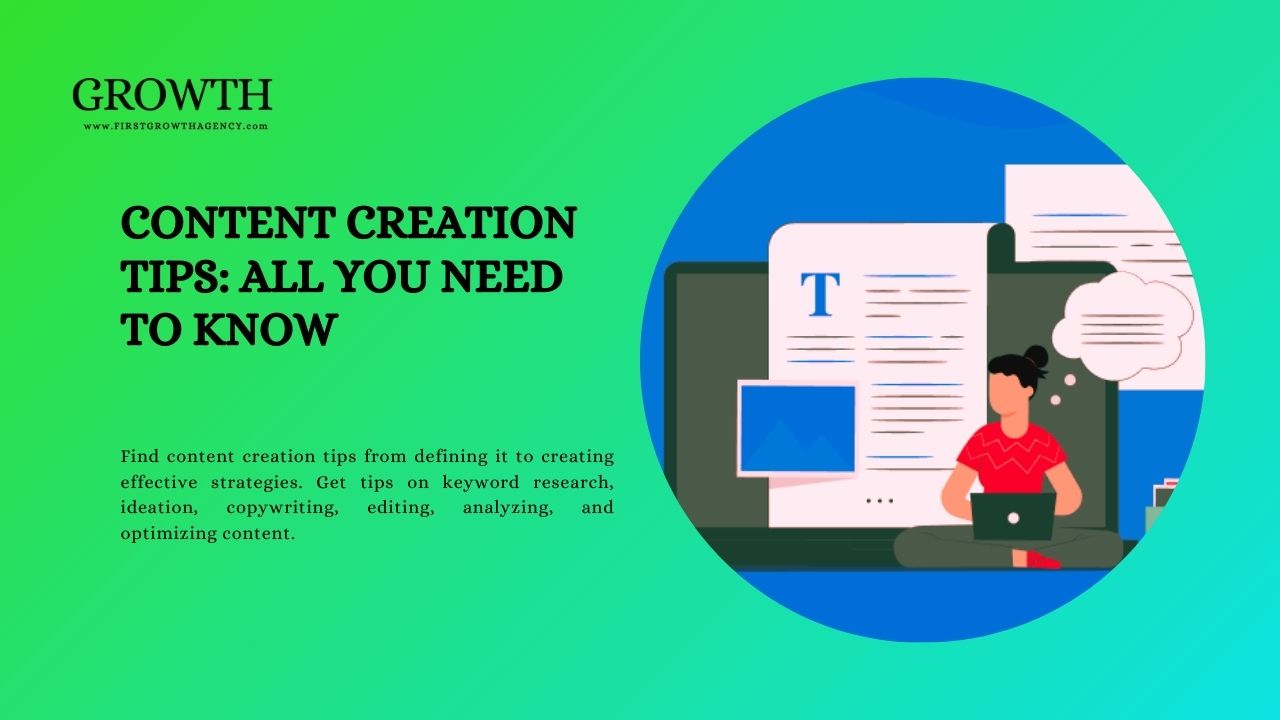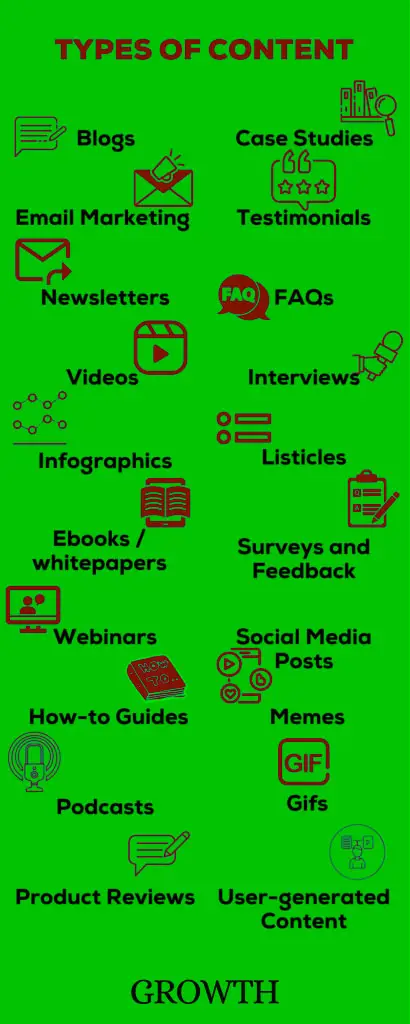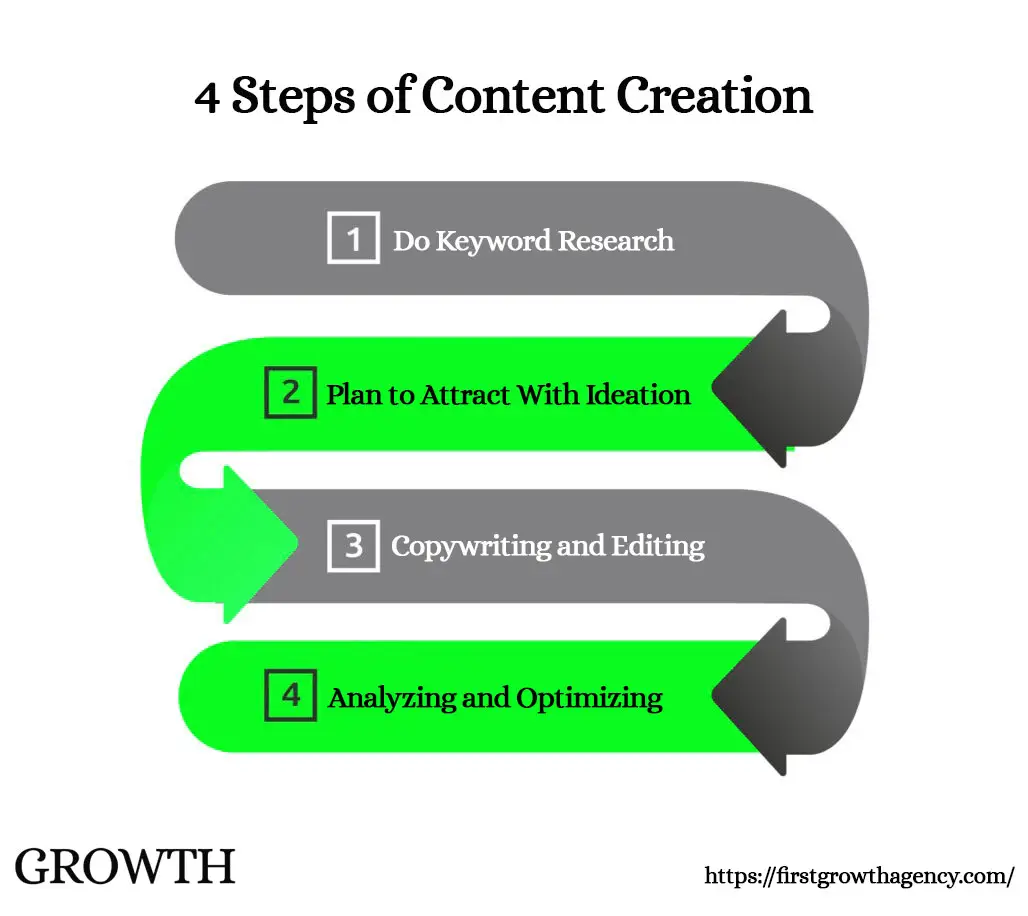You need content to advertise a business. The ads, landing pages, blog posts, newsletters, texts, and help articles? All of them are examples of content. Content is how you talk to leads and customers. You get leads and customers by using content. It brings you more people to your website and helps your company make money. Lots of marketers are spending more on content because it works well. For example, half of them plan to spend more this year. And nearly 40% say it’s a big part of their plans. Also, 10% think blogging gives them the most for their money.
What is Content Creation?
Creating content involves generating ideas that resonate with your audience and transforming them into blogs, videos, or infographics. Different experts contribute to this process, from planning the content to its actual creation.
5 Types of Content Creation
1) SEO Blog Articles
Blogs are platforms for creators to educate, entertain, and inspire their audience. They are useful in marketing, with 56% of marketers recognizing their value. Blogs started a long time ago and, to date, continue to hold promise for engaging audiences and improving search engine visibility.
Content creation for blogs involves engaging and informing audiences with strategies like answering common questions and providing in-depth comparisons, tutorials, and step-by-step guides. Recurring series, quizzes, curated content, and celebratory posts also help engage audiences and foster community.
Using AI content writers can simplify blogging, helping creators produce high-quality posts efficiently. This way, bloggers can establish a solid online presence, drive traffic, and convert more. Blogs remain a powerful medium for connecting with audiences and fostering meaningful relationships.
2) Podcasts
Podcasts are popular, with 28% of Americans aged 12 and above tuning in weekly. Hosts rely on likability and expertise to draw in audiences. Consistency and authenticity are crucial, and newcomers should adhere to regular posting schedules and maintain a structured format for each episode.
Consistency and authenticity are important for new podcast creators. Having a regular posting schedule and a clear structure for each episode can help build audience loyalty. Content creation varies, from sharing professional expertise to conducting influencer interviews. Doing thorough research and asking thoughtful questions can make interview-based episodes more engaging and encourage guests to return or recommend others.
Different ways to make podcasts are by researching and asking good questions. You can also make more people interested by following trends and having fun contests. It’s important to make sure that the podcast stays interesting for people. The most important thing is to make sure that people like listening to the podcast, whether it’s through stories, interviews, or fun things to do.
3) Videos
Video marketing has become very popular, with both short-form and long-form content strategies. 86% of video marketers say that video is effective for lead generation. It’s important for video content creators to produce original videos that interest their audience.
Creating video content involves a wide variety of formats, from long webinars to short tips and explainer videos, as well as TV commercials, bumper ads, and slideshow-style ads in facebook video creation. All of it can be resource-intensive, but by using an AI video editor, it can help you efficiently produce video ad content within your budget, saving you time and money.
Using animation can make it easier to explain complex or new information, helping viewers understand how products work or how to solve problems. By creating familiar situations using digital animation or stop-motion techniques, we can make it easier for people to understand difficult ideas. Converting popular blog content into videos with voiceovers or adapting them for Facebook or instagram using content creation tools for social media can also help more people access the information.
4) Images
Image-based content, including infographics, photography, GIFs, memes, and illustrations, is required for modern digital communication. One must master fundamental principles like selecting appropriate subjects, considering composition, and maintaining simplicity for effective visual communication.
Remember these tips for creating content. Visual storytelling means vividly portraying scenes to captivate viewers. When using user-generated content, make sure to get proper permissions and give credit. Infographics are effective for improving understanding and retention. To create successful infographics, select relevant data and craft clear narratives.
Showing behind-the-scenes moments also helps build trust and connection with the audience. When businesses plan and share carefully crafted visuals, they can tell engaging stories and create meaningful connections with their audience.
5) Downloadables
Downloadable content like templates, whitepapers, and ebooks are valuable for businesses to generate leads. Lead generation is crucial for content success, making it important to integrate content creation with content offers to attract new leads. Lead magnets should address urgent issues and offer lasting value to convert leads into satisfied customers.
You can use different types of stuff to make cool downloads. Ebooks and whitepapers give you lots of info about things or how to solve important problems. Original research gives you good info based on facts. Content creation tools and templates, like calculators and checklists, help you do stuff and make people like your brand. Kits and workbooks put together things to help you solve problems and have fun while learning.
To create effective downloadable content offers, focus on utility and use accessible tools like Microsoft Excel or Google Docs. Structure content in manageable segments and incorporate multimedia for engagement. Consistently delivering valuable content attracts and retains leads, driving brand growth and customer satisfaction.
Read: Digital Marketing 101: What is SEO, SEM, and SMM?
How to Make a Content Strategy and Plan
By following these steps and customizing them to suit its specific goals and audience, your services or products can develop a robust content strategy that resonates with potential customers and drives business growth.
Define Clear Goals
Start by setting specific, measurable, achievable, relevant, and time-bound (SMART) goals for your content. These goals should align with your broader marketing objectives. It can be something like an aim to increase website traffic by 25% within the next quarter.
Understand Your Audience
Developing detailed buyer personas helps you tailor your content to resonate with consumers’ needs and preferences. A workout clothes brand learns about its customers—like people who love to exercise and those who wear activewear for style.
Map Content to the Buyer’s Journey
Consider the different stages of the buyer’s journey—awareness, consideration, and decision-making. Create content that addresses each stage, from educating prospects to guiding them towards making a purchase decision. First, with tips for beginners. Then, comparing products. Lastly, with detailed reviews to help decide.
Conduct a Content Audit
Check your writing to see what’s good and what needs fixing. Organize your content based on factors like target keywords, buyer persona, and stage of the buyer’s journey. You might be good at blogs but not so great as a social media content creator. So this audit helps you refine your content strategy and ensure consistency.
Choose the Right Content Formats
Choose content formats that your audience finds easy to understand and that match your goals. Whether it’s blog posts, videos, infographics, or podcasts, select formats that connect with your audience. For e.g., If you’ve a cooking site, visual content is better because people prefer watching videos to reading recipes.
Check: 7 Proven Reasons Why Digital Video Is Important
4 Steps to Content Creation
Busy marketers make systems for everything they do, like creating content, to save time and be more creative.
Step 1: Do Keyword Research
To understand the keywords well, you need to know what people like. You can do this by making a buyer persona which is actually a picture of the type of person who would like your stuff. This helps you know what to write about. You also need to look at the content your competitor’s sites are producing. This will help you decide what to write about first.
When you look for keywords to use on your website, pick ones that are not too popular or have too much difficulty. If your website is not very strong, you won’t get many visitors if you use very popular keywords. You can make your website stronger by putting up good stuff that other websites link to. Start by using less popular, more specific keywords. This will help more people find your website.
There are different ways to do keyword research, such as using tools like SEMRush or Ahrefs, looking at search engine suggestions, or checking related searches on result pages. This helps you find good keywords matching what your audience looks for, improving your content’s visibility and attracting more visitors to your blog.
Step 2: Plan to Attract With Ideation
Remember to pick the right keywords before you start thinking of ideas. Experts say you should group your ideas into clusters. A main page connects all the related ideas together. To get ideas, you can look at words people search for, check the numbers, ask the sales team for common questions, see what others are doing, and ask people for their thoughts. Keeping all your ideas in one place will help you not lose them.
The topic cluster model helps organize ideas by making a main page for a keyword and adding more pages about related topics. This helps make sure the content has everything it needs and can target specific keywords. You can get ideas from books, studies, other websites, or things people search for.
After getting ideas, it’s important to make a plan and start making content. This helps make things easier and ensures that each piece of content helps reach the main goal. By following this process, businesses can become an authority, get the right people to visit their content, and keep their audience interested.
Step 3: Copywriting and Editing
When you create content, it’s important to think about who you’re making it for. Use their language, jokes, and point of view to connect with them. Also, make it clear why your content matters right from the start. Use catchy titles and teasers to show why it’s worth their time. Writing is super important because it’s usually where everything starts.
Make your content special by adding your own style or sharing new ideas to support what you’re saying. Stick to one main idea in each piece so you don’t confuse your audience with random stuff. Be yourself and make sure your writing is clear and to the point.
When editing, focus on making sure everything is clear, correct, and matches your style and topic. Use tools like Grammarly to help with this. But remember, you don’t have to be perfect. The main thing is to finish and publish your work on time. You can always update or improve it later. Be practical about editing, knowing that progress is more important than perfection in the world of content creation..
Step 4: Analyzing and Optimizing
The final step in content creation is analyzing your content. Without data, you can’t know what’s working or how to improve it. Several data points could be tracked, so use your goals to set parameters. Metrics like page views, organic traffic, bounce rates, conversion rates, engagement rates, audience growth, time on page, and the impact of paid campaigns provide crucial insights for optimizing content.
Select metrics that align with your goals. Whether increasing visibility, engagement, or conversions, chosen metrics guide your strategy. Consider page views, organic traffic, bounce rates, conversion rates, engagement rates, audience growth, time on page, and paid campaign impact for data-driven content optimization.
Remember, using data to make decisions in content marketing is important. It means we don’t just rely on being creative, but also look at numbers and information. By paying attention to what words are popular and what people like, we can make content that’s both creative and based on good information.
Related: Digital Marketing Challenges to Consider in 2024
Conclusion
Good content is really important for online marketing. To make good content, a company needs to set clear goals, have personalized content creation tips, know its audience, make different kinds of content, check how well the content is doing, and use words that people are searching for. By doing these things, a company can make sure its content is interesting and helps the company grow. You can also content us for your content writing or marketing needs.



